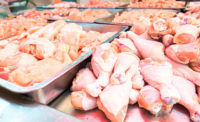Consumer Reports, NCC speak out about safety of chicken products

Consumer Reports has issued a report on its latest study on chicken breasts purchased at supermarkets. Consumer Reports found bacteria that could make consumers sick on nearly all of the 316 raw chicken breasts purchased at retail nationwide. The full report, "The High Cost of Cheap Chicken," is featured in the February 2014 issue of Consumer Reports and online at www.ConsumerReports.org.
While Consumer Reports has consistently been testing chicken for more than 15 years, this is the first time it has looked at the contamination rates for six different bacteria – enterococcus (79.8 percent), E. coli (65.2 percent), campylobacter (43 percent), klebsiella pneumonia (13.6 percent), salmonella (10.8 percent), and staphylococcus aureus (9.2 percent). It also evaluated every bacterium for antibiotic resistance and found that about half the chicken samples harbored at least one multidrug-resistant bacteria.
As part of this investigation, the Consumer Reports National Research Center recently conducted a nationally representative survey of 1,005 respondents about their understanding of labels and their handling and cooking habits for chicken. The survey found that more than half of respondents thought that "natural" chickens did not receive antibiotics or genetically modified feed and more than one-third thought "natural" was equal to "organic," all of which are not true.
"Our tests show consumers who buy chicken breast at their local grocery stores are very likely to get a sample that is contaminated and likely to get a bug that is multidrug resistant. When people get sick from resistant bacteria, treatment may be getting harder to find," said Dr. Urvashi Rangan, a toxicologist and Executive Director of the Consumer Reports Food Safety and Sustainability Center. "Our survey also shows that consumers are making buying decisions based on label claims that they believe are offering them additional value when that is not in fact the case. The marketplace clearly needs to change to meet consumer expectations."
In response, the National Chicken Council pointed out in its own release that Americans eat about 160 million servings of chicken every single day, and 99.99 percent of those servings are consumed safely.
“Unfortunately, this particular statistic was left out of the "in depth" piece recently published by Consumer Reports,” the associated said.“U.S. chicken producers rely upon the best science, microbiology and technology to reduce food-borne pathogens, and spend tens of millions of dollars every year in the name of food-safety research which can be credited with the significant decrease in foodborne pathogens present in chicken over the last several years.”
"The belief that affordable food means it is lower in quality or compromised in some way stands in stark contrast to the hard work and efforts of American agriculture, USDA and the hundreds of thousands of U.S. farmers and food producers who work tirelessly to produce a quality protein that is the envy of the world and enjoyed by millions of Americans," said National Chicken Council President Mike Brown.
From 2001 to 2010—the latest 10-year period for which data are available—outbreaks related to E. coli, Salmonella and other pathogens decreased by more than 40 percent. In the past five years, Salmonella in chickens has decreased by 55 percent.
"Eliminating bacteria entirely is always the goal," Brown added. "But in reality, it's simply not feasible."
Any raw agricultural product, including fresh fruit, vegetables, meat and poultry, is susceptible to naturally occurring bacteria. Whether it's labeled "organic," "natural," purchased in the grocery store or at your local farmers' market, there is the potential that fresh food could make us sick, if improperly handled or cooked, NCC noted.
Which is why the National Chicken Council agrees with Consumer Reports on one point—we all play an important role in ensuring food safety for our families, from the farm to the table.
"No legislation or regulation can keep bacteria from existing," Brown added. "The only way to ensure our food is safe 100 percent of the time is by following science-based procedures when raising/growing, handling and cooking it. Right now, we're at 99.9% but we're going to keep working to reach 100.
"We take the safety of our chicken very seriously," said Brown. "After all, our families are eating the same chicken as you and yours.”
Sources: Consumer Reports, NCC
Looking for a reprint of this article?
From high-res PDFs to custom plaques, order your copy today!








